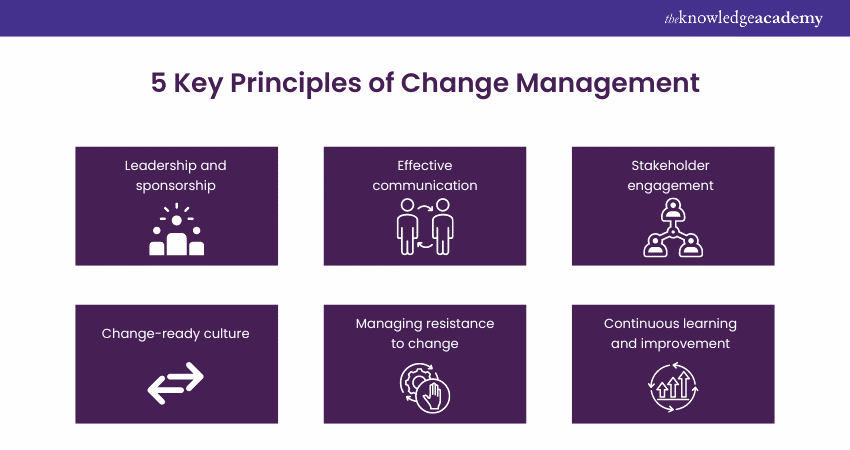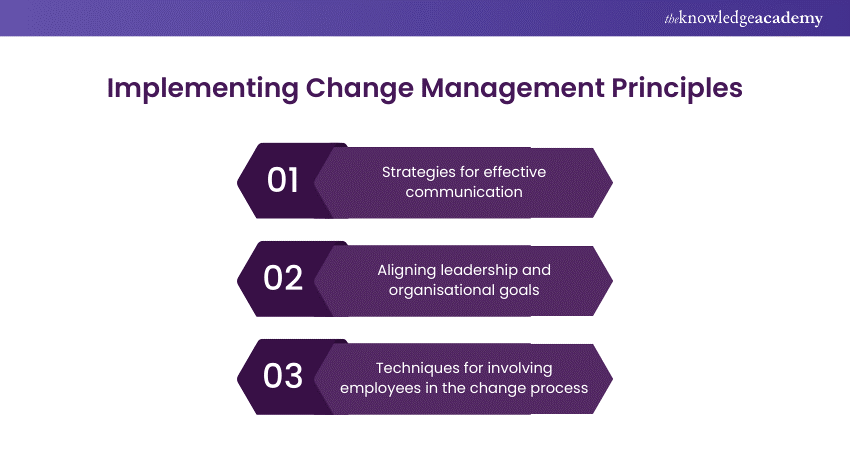We may not have the course you’re looking for. If you enquire or give us a call on 01344203999 and speak to our training experts, we may still be able to help with your training requirements.
Training Outcomes Within Your Budget!
We ensure quality, budget-alignment, and timely delivery by our expert instructors.

Managing Change is essential as businesses face constant shifts and evolving market dynamics. This process involves a structured approach within the change management plan to transitioning individuals, teams, and organizations from one state to another. This is why implementing Change Management becomes vital for organisational success in today's fast-paced world. However, to implement it properly, the companies must understand the Change Management Principles to implement and manage the change effectively. Want to know how are these Change Management Principles helpful? In this blog, we will discuss these Principles and the benefits of implementing these principles. Delve in to learn more!
Table of Contents
1) What is Change Management?
2) Why are Change Management Principles important?
3) Five key Principles of Change Management
4) Implementing Change Management Principles
5) Conclusion
What is Change Management?
There is no one way to define Change Management. There are many different Change Management Models, drawing on theories from various disciplines such as Psychology, Behavioural Science, Engineering, and Systems Thinking. Two popular Change Management models are as follows:
a) Lewin's Change Management Model: Lewin's Change Management Model splits the process into three stages known as 'unfreeze-change-refreeze.
b) Kotter's 8-Step Change Model: It provides a more detailed guide through the change process.
Change Management theories emphasize that in any organization, everyone and everything is connected. However, with efficient Change Management tools, it is possible to encourage everyone to adopt and embrace new working methods. A well-executed change management strategy facilitates this adoption process smoothly.

Why are Change Management Principles important?
Things will inevitably change, and individuals need to develop strategies to manage and navigate through anticipated or unexpected transitions. How leaders and teams work disruptions and changes directly impact business outcomes, determining whether an organisation thrives.
Change Management initiatives often fail and must be intentional, strategic, and well-coordinated. However, organisations that foster Change Management Principles are more likely to experience successful transitions, minimise downtime, and have satisfied and secure employees.
Ready to lead and drive success? Enroll in our Change Management Certification program to gain the skills and credentials you need.
Five Key Principles of Change Management
Change Management Principles serve as guiding frameworks for effectively navigating and managing organisational transitions. Companies can successfully implement change at the workplace and minimise resistance by complying with the following Principles. They include the following:

Leadership and sponsorship
Strong leadership is essential for driving change. Leaders must articulate a clear vision, actively support the change effort, and serve as role models for employees. They should provide the necessary resources, establish accountability, and empower employees to embrace the change.
Leadership and sponsorship are vital in Change Management. Effective leaders provide a clear vision, align the change with organisational goals, inspire and engage employees, allocate resources, and serve as role models. They create a supportive environment for change, guiding and driving the process towards successful implementation.
Discover the Best Change Management Books! Read our top picks and transform your organization today!
Effective communication
Open and transparent communication is crucial throughout the change process. Clear and timely communication helps employees understand the reasons for change, the expected impact, and their role in the process. It fosters trust, reduces uncertainty, and encourages engagement and collaboration.
Effective communication is crucial in Change Management. It involves clear and timely dissemination of information, active listening, and two-way dialogue. Transparent communication builds trust, reduces uncertainty, and engages employees in the change process, increasing their understanding, commitment, and support for the change initiatives.
Discover the Impact of Change Management Salaries on Career Growth and Organizational Success!
Stakeholder engagement
Involving stakeholders at all levels is vital for successful Change Management. Stakeholders, including employees, customers, and external partners, should be engaged early on, providing opportunities for input, addressing concerns, and gaining support. Their involvement fosters a sense of ownership and increases the chances of successful change adoption.
It is crucial in Change Management. It involves involving key stakeholders, such as employees, customers, and external partners, in the change process. By seeking their input, addressing concerns, and gaining support, organisations can foster ownership, collaboration, and successful adoption of change initiatives.
Unlock your organisation's potential with our Change Management Foundation Course - embrace change, drive success!
Change-ready culture
Building a culture that embraces change is critical. Organisations should foster an environment encouraging innovation, continuous learning, and adaptability. This involves promoting a growth mindset, encouraging risk-taking, and recognising and rewarding individuals and teams contributing to positive change.
A change-ready culture is an organisational environment that embraces change as a natural and necessary part of growth. It promotes a mindset of continuous learning, innovation, and adaptability. A change-ready culture encourages employees to embrace new ideas, take risks, and actively contribute to successful change implementation.
Managing change resistance
Resistance to change is natural and should be expected. Change Management Principles emphasise the importance of understanding and addressing resistance. This involves actively listening to concerns, providing support and training, and involving employees in the change process. By managing resistance effectively, organisations can increase acceptance and commitment to change.
Managing change resistance is crucial in Change Management. It involves understanding and addressing the concerns, fears, and scepticism that individuals may have towards the change. Organisations can reduce resistance and increase acceptance of the change initiatives by actively listening, providing support, involving employees in the Change Management communicating the benefits.
Get Paid What You Deserve! Find out the latest change manager salary data. Learn More!
Continuous learning and improvement
Change is an ongoing process, and organisations must continuously learn and improve their Change Management practices with the help of a change management consultant. This includes capturing lessons learned, soliciting feedback, and adapting Change Management to the changing needs and dynamics of the organisation. Continuous improvement ensures that change initiatives become more effective over time.
Continuous learning and improvement are essential in Change Management. It involves gathering feedback, analysing outcomes, and adjusting to improve future change initiatives. By capturing lessons learned, organisations can enhance their Change Management processes, adapt to evolving circumstances, and drive successful change implementation.
By adhering to these key Change Management principles, organisations can foster a supportive environment for change, enhance employee engagement, and increase the chances of successful change implementation. These principles guide leaders and Change Management practitioners in effectively navigating the complexities of organisational transitions.
Wish to know more about change management? Sign up for our Change Management Practitioner course now!
Implementing Change Management Principles
Implementing Change Management Principles ensures smooth transitions and minimises resistance by engaging stakeholders and aligning their expectations. Let us see further how they are implemented:

Strategies for effective communication
Change Management Principles can be implemented with effective communication. Let us see how:
a) Outlining objectives, key messages and target audiences help in ensuring that the plan can answer all probable questions related to Change.
b) Using variety of Change Management channels to ensure that all departmentsof the organisation are update about the newly implemented changes. Some of these channels can be mails, posts, videos, etc.
c) Tailoring the message within different groups to help the organisation develop a personalised approach. This increases relevance and less chance of misunderstanding.
d) With the help of effective communication, organisational leaders and managers can involve the rest of the organisation in the process of Change Management.
e) Clearly articulating the benefits and loss of the Change Management process helps the rest of the organisation to understand the importance of the process.
Do you want to improve your job prospects in Change Management? Then register now for our Certified Professional Change Management (CPCM) Course!
Aligning leadership and organisational goals
Aligning leadership and organisational goals is crucial for the successful implementation of Change Management Principles. Let us see how:
a) By clearly defining the objectives of the Change initiative, employees can better understand how the Change Management aligns with the organisation's goals.
b) If the leadership and the management is involved from an early stage onwards it is possible that the resources and support that is required to implement the Change Management Principles are in place.
c) All the vision, objectives, and goals of the Change Management should be communicated to its employees so that the effort towards it is effective.
d) Creating committees where the leadership and the management are in charge will help in establishing governance structure, which plays a crucial role in implementing the Principles.
e) Fostering a culture of open communication in the organisation, so that employees can voice out their concerns without feeling stressed.
Get ready for your interview with our top Change Management Interview Questions.
Techniques for involving employees in the change process
Involving employees in the Change Management process is the key to successful implementation of change. Let's see how you can employ effective techniques to involve employees in the change process:
a) With the help of active listening, you can help employees voice out their opinions and gain feedback on what they think about the change process. This will make them feel included and be interested in participating more in the process.
b) Allow opportunities for employees to get involved, such as creating task force committees or contributing to problem-solving scenarios.
c) Recognition and appreciation always help. Recognise and appreciate employees who make significant contributions to the change process.
d) You can provide training programs to help develop more opportunities for employees to participate in the change process.
Try to set small goals first and let the employees accomplish them. This will give them a sense of achievement and more enthusiasm to pursue bigger and more complex goals in the change process.
Dive into the detailed Case Study on Change Management
Conclusion
Change Management is critical for organisations navigating transitions in today's dynamic business landscape. Organisations can increase the likelihood of successful change implementation by understanding the principles, following a structured Change Management addressing common challenges. Embracing Change Management Principles empowers organisations to adapt, grow, and thrive in constant change, ensuring long-term success and sustainability.
Learn how you can manage change with Agile Methodology – register now with our Managing Change with Agile Methodology Training!
Frequently Asked Questions

The 7 Cs of Change Management are a framework designed to guide organisations through change processes effectively. They are Communication, Commitment, Collaboration, Culture, Capability, Champions, and Celebration.

The four principles of Change Management are:
a) Understanding Change,
b) Planning Change,
c) Implementing Change,
d) Communicate Change

The Knowledge Academy offers various Change Management Certification courses, including Change Management Foundation, Practitioner, and Risk Management for Change Training. These courses cater to different skill levels, providing comprehensive insights into Change Management skills.
Our Project Management blogs covers a range of topics related to Change Management, offering valuable resources, best practices, and industry insights. Whether you are a beginner or looking to advance your Change Management skills, The Knowledge Academy's diverse courses and informative blogs have you covered.

The Knowledge Academy’s Knowledge Pass, a prepaid voucher, adds another layer of flexibility, allowing course bookings over a 12-month period. Join us on a journey where education knows no bounds.

The Knowledge Academy takes global learning to new heights, offering over 30,000 online courses across 490+ locations in 220 countries. This expansive reach ensures accessibility and convenience for learners worldwide.
Alongside our diverse Online Course Catalogue, encompassing 17 major categories, we go the extra mile by providing a plethora of free educational Online Resources like News updates, Blogs, videos, webinars, and interview questions. Tailoring learning experiences further, professionals can maximise value with customisable Course Bundles of TKA.
Upcoming Project Management Resources Batches & Dates
Date
 Change Management Foundation & Practitioner
Change Management Foundation & Practitioner
Mon 29th Jul 2024
Mon 12th Aug 2024
Sat 17th Aug 2024, Sun 18th Aug 2024
Tue 27th Aug 2024
Mon 9th Sep 2024
Sat 14th Sep 2024, Sun 15th Sep 2024
Mon 23rd Sep 2024
Mon 7th Oct 2024
Sat 12th Oct 2024, Sun 13th Oct 2024
Mon 21st Oct 2024
Mon 28th Oct 2024
Mon 4th Nov 2024
Sat 9th Nov 2024, Sun 10th Nov 2024
Mon 11th Nov 2024
Mon 18th Nov 2024
Mon 25th Nov 2024
Mon 2nd Dec 2024
Sat 7th Dec 2024, Sun 8th Dec 2024
Mon 9th Dec 2024
Mon 16th Dec 2024
Mon 6th Jan 2025
Mon 13th Jan 2025
Mon 20th Jan 2025
Mon 27th Jan 2025
Mon 3rd Feb 2025
Mon 10th Feb 2025
Mon 17th Feb 2025
Mon 24th Feb 2025
Mon 3rd Mar 2025
Mon 10th Mar 2025
Mon 17th Mar 2025
Mon 24th Mar 2025
Mon 31st Mar 2025
Mon 7th Apr 2025
Mon 28th Apr 2025
Mon 12th May 2025
Mon 19th May 2025
Mon 9th Jun 2025
Mon 23rd Jun 2025
Mon 7th Jul 2025
Mon 21st Jul 2025
Mon 4th Aug 2025
Mon 18th Aug 2025
Mon 1st Sep 2025
Mon 15th Sep 2025
Mon 29th Sep 2025
Mon 13th Oct 2025
Mon 20th Oct 2025
Mon 27th Oct 2025
Mon 3rd Nov 2025
Mon 10th Nov 2025
Mon 17th Nov 2025
Mon 24th Nov 2025
Mon 1st Dec 2025
Mon 8th Dec 2025
Mon 15th Dec 2025







 Top Rated Course
Top Rated Course


 If you wish to make any changes to your course, please
If you wish to make any changes to your course, please


